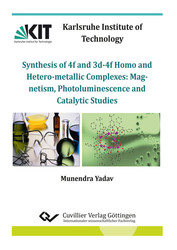| Departments | |
|---|---|
| Book Series (96) |
1378
|
| Nachhaltigkeit |
3
|
| Gesundheitswesen |
1
|
| Humanities |
2364
|
| Natural Sciences |
5406
|
| Mathematics | 229 |
| Informatics | 319 |
| Physics | 980 |
| Chemistry | 1363 |
| Geosciences | 131 |
| Human medicine | 243 |
| Stomatology | 10 |
| Veterinary medicine | 108 |
| Pharmacy | 147 |
| Biology | 835 |
| Biochemistry, molecular biology, gene technology | 121 |
| Biophysics | 25 |
| Domestic and nutritional science | 45 |
| Agricultural science | 1004 |
| Forest science | 201 |
| Horticultural science | 20 |
| Environmental research, ecology and landscape conservation | 148 |
| Engineering |
1793
|
| Common |
98
|
|
Leitlinien Unfallchirurgie
5. Auflage bestellen |
|
Advanced Search
Synthesis of 4f and 3d-4f Homo and Heterometallic Complexes: (English shop)
Magnetism, Photoluminescence and Catalytic Studies
Munendra Yadav (Author)Preview
Table of Contents, PDF (120 KB)
Extract, PDF (420 KB)
The term “lanthanide” was introduced by Victor Goldschmidt with the name of its first element “lanthanum”.1It has the outer electronic configuration 6s25d14f0, so it can either be considered as a d-block elements or an f-block element. The relative energy of the 5d and 4f orbitals are very similar and sensitive to occupancy of orbitals but on the basis of stability of 4f shell which is slightly more compare to 5d shell, it was considered as f-block element. This criterion was followed by next 14 elements and electrons enter in the 4f shell until at lutetium.2The lanthanides are 15 elements in the periodic table considered as the first f-block elements, starting from lanthanum (59La) to lutetium (71Lu), which are commonly referred as “rare earth metals” along with scandium and yttrium. They are chemically represented by the symbol “Ln”.
| ISBN-13 (Hard Copy) | 9783954049615 |
| ISBN-13 (eBook) | 9783736949614 |
| Final Book Format | A5 |
| Language | English |
| Page Number | 152 |
| Lamination of Cover | matt |
| Edition | 1. Aufl. |
| Publication Place | Göttingen |
| Place of Dissertation | Karlsruhe |
| Publication Date | 2015-03-27 |
| General Categorization | Dissertation |
| Departments |
Inorganic chemistry
|








